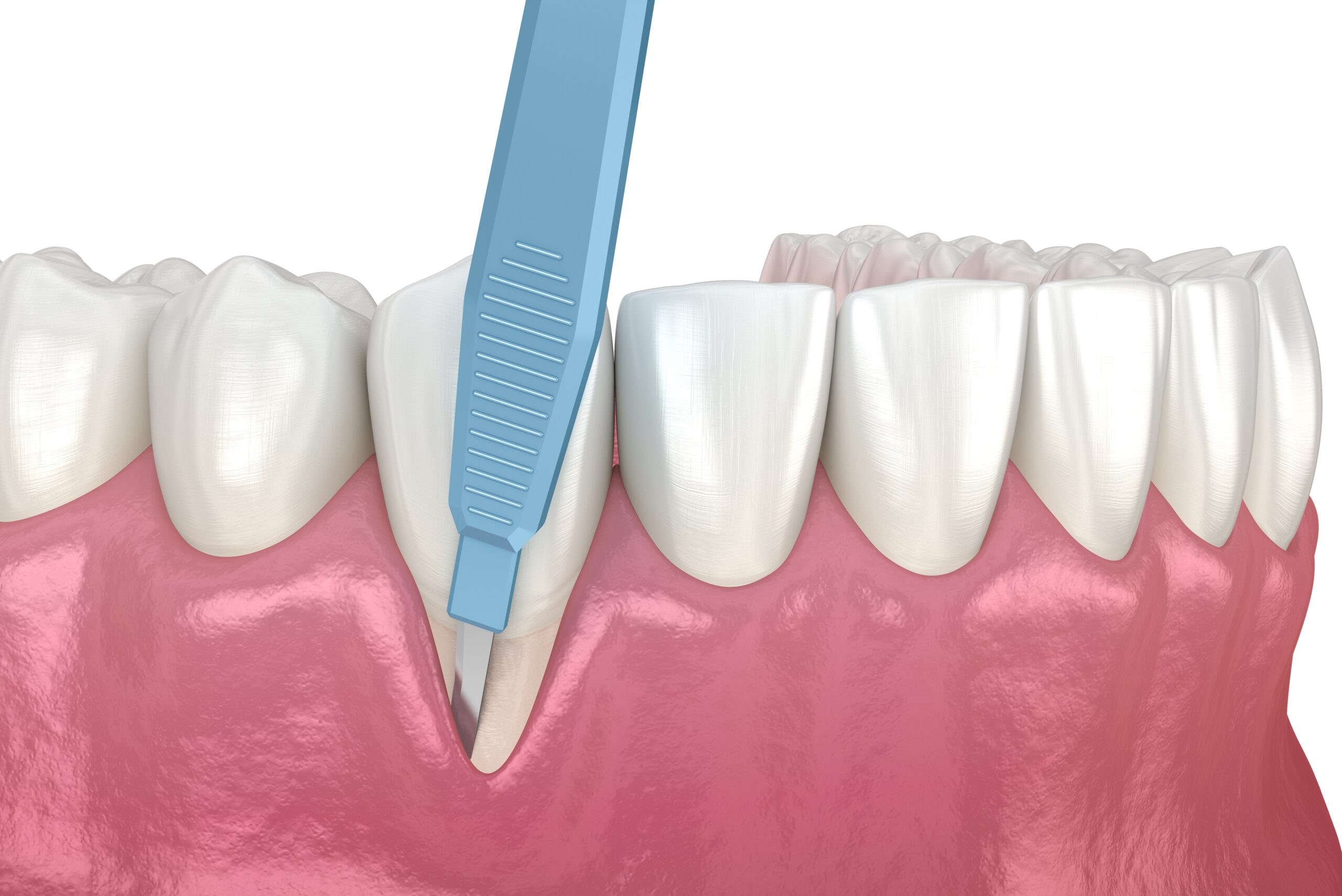Periodontal/ Surgical Clean
General Dental Care in Merrylands
Periodontal Clean
Periodontal cleaning, also known as deep scaling and root planing, is a surgical procedure aimed at addressing gum disease. This comprehensive process involves the meticulous removal of plaque and tartar from tooth and root surfaces using specialized ultrasonic instruments. Root planing not only reduces inflammation but also eliminates infection, fostering the healing of gum tissue. Following the cleaning, it’s crucial to uphold excellent oral hygiene habits at home and attend routine dental check-ups to effectively prevent the reccurence of gum disease.
Periodontal Clean Procedure
Assesment
The assessment includes comprehensive examination of teeth , recording pocket depth, amount of plaque and tartar to assess the extent of gum attachment loss. An OPG Xray may be taken to evaluate bone levels and identify any underlying issues. The collected data is then analyzed and then categorized into different disease stages and levels. Based on this analysis, the prognosis of the tooth’s condition is determined, guiding treatment decisions and personalized care plans tailored to address the patient’s specific needs and goals.
Deep Scaling
Periodontal cleaning is performed under local anesthesia for patient comfort and is often done one quadrants a visit to ensure thorough treatment of the entire mouth. Using specialized ultrasonic scalers and hand instruments, the dentist removes plaque and calculus deposits from both the tooth and root surfaces thoroughly specially targeting areas between roots and under gums affected by periodontal disease.
Antibacterial Medications
In addition to scaling and root planing, local antimicrobial gels are applied to the gum tissues to further combat infection and promote healing. These gels contain antimicrobial and anti inflammatory properties that help reduce bacteria levels and inflammation in the periodontal pockets. Patients are advised an intensive oral hygiene regimen and use of oral antibacterial rinses and application of chlorhexidine gel interdentally to maintain oral hygiene between professional cleanings.
Maintenance Visits
Maintenance visits every three months are recommended initially until the gums have stabilized and periodontal health has improved. During these visits, the dentist performs a final recording of pocket depths and compares them to previous charting to assess the effectiveness of treatment. These regular check-ups allow for ongoing monitoring of gum health and provide opportunities to address any emerging issues before they progress. By combining professional periodontal cleaning with diligent home care and regular maintenance visits, patients can achieve optimal oral health and prevent the recurrence of gum disease.
Post Procedure Instructions
Following a periodontal cleaning, maintaining proper home care is crucial for supporting gum health and preventing the recurrence of periodontal disease.
Brush meticulously: Brush your teeth thoroughly with a soft-bristled toothbrush and high fluoride toothpaste at least twice daily, paying close attention to the gumline and areas where plaque tends to accumulate.
Floss thoroughly: Floss between every tooth daily to remove plaque and food debris from areas that your toothbrush cannot reach. Interdental brushes can be used in areas with large spaces between teeth. Using a Waterpik is an effective method for both flossing and flushing out food debris between teeth.
Use chlorhexidine mouthwash: It is recommended for first 3 weeks after perio therapy to reduce bacterial load. Avoid rinsing your mouth with water or eating or drinking for at least 30 minutes after using chlorhexidine to allow the active ingredients to take effect. Alternatively Chlorhexidine gel can be applied on gums at night to promote healing of the gum tissues.
Oral antibiotics: Take any prescribed oral antibiotics as directed to combat stubborn infections or prevent complications following periodontal cleaning. It’s essential to complete the full course of antibiotics as prescribed, even if symptoms improve, to ensure effective treatment and prevent antibiotic resistance.
Food Habits: In addition to these home care instructions, it’s important to avoid smoking and limit consumption of high-sugar foods and beverages, as these can contribute to gum inflammation and increase the risk of periodontal disease.
Frequently Asked Questions
Are there any risks or potential complications?
Periodontal cleaning, while generally safe, may carry risks such as temporary sensitivity, discomfort, or pain during and after the procedure. There’s a slight risk of infection if proper post-treatment care isn’t followed. Additionally, aggressive cleaning techniques could potentially contribute to gum recession in some cases.
Will I experience any pain or discomfort?
You might experience mild discomfort or sensitivity after the periodontal cleaning procedure. This should resolve within a few days. In the meantime , use pain medication as directed or use desentizing gels.
What is the proper way to brush and floss teeth?
Maintain meticulous oral hygiene by brushing with fluoride toothpaste twice daily, focusing on the gumline and plaque-prone areas. Floss daily between each tooth, supplementing with interdental brushes for larger spaces. Consider using a Waterpik to effectively flush out debris and enhance oral hygiene.
Are there any foods or activities I should avoid?
After a periodontal cleaning, it’s best to avoid hard or crunchy foods that could irritate your gums or cause bleeding . Additionally, refrain from smoking as it can hinder healing process and increase the risk of complications. Maintain good oral hygiene to promote healing .